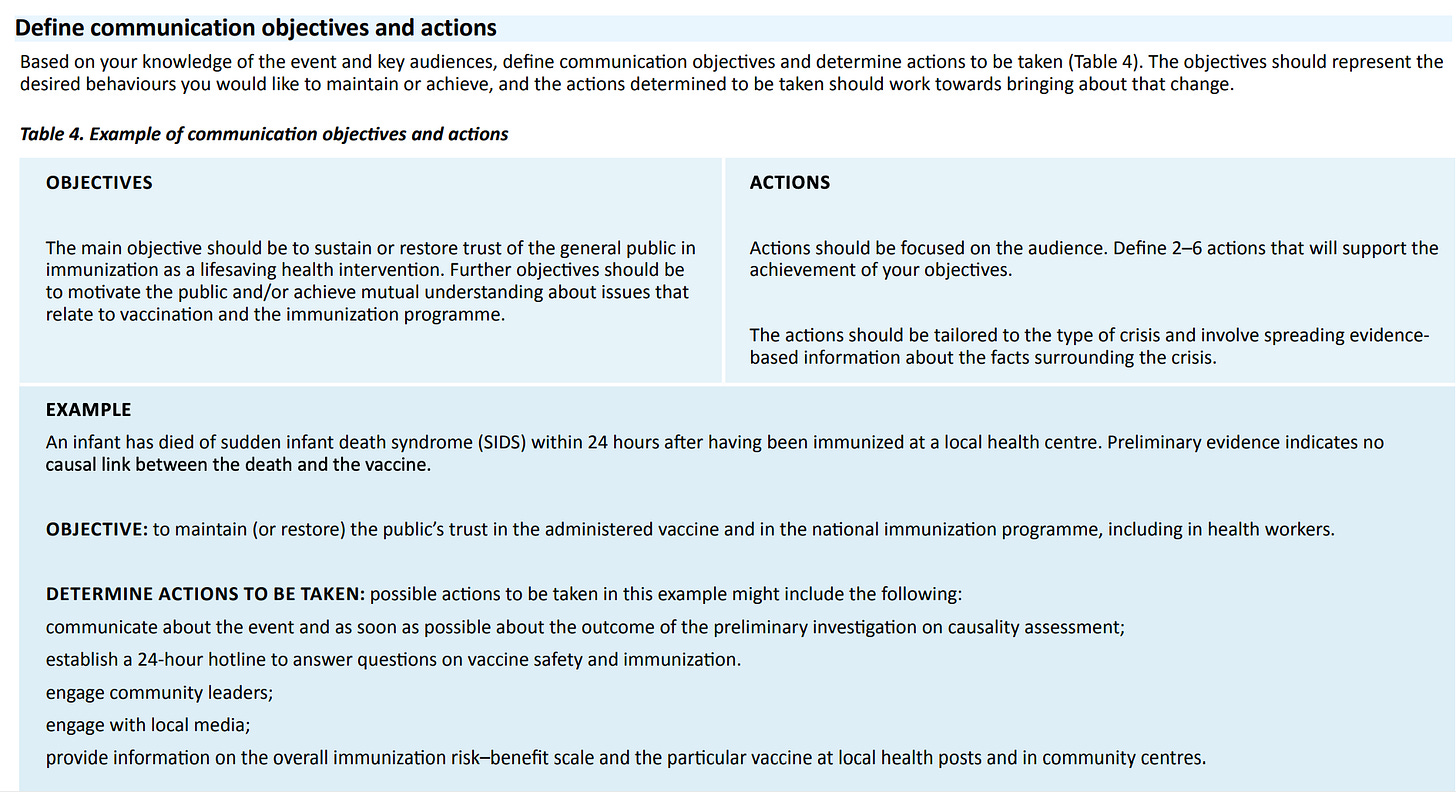The Vaccine-Injured are further victimized by WHO-trained "Fixers"
a look inside the vaccine program damage control initiative
Do you ever stop to notice how we’re encouraged to make flying leaps to the conclusion that sudden deaths are related to climate change (which the WHO claims is the “single biggest health threat facing humanity” ), but it’s insensitive to wonder whether someone was recently boosted (despite scientific data that demonstrates strong temporal and biological links)?
It’s all thanks to organizations like the World Health Organization (WHO), who work hard to avert any crisis that may lead to vaccine hesitancy and redirect people to come to their predetermined conclusions about what’s wrong with the world (ie. overpopulation, vaccine hesitancy, climate change). To this end, the WHO has published a Vaccine Crisis Communication Manual: A Step-by-Step Guidance for National Immunization Programmes.
This is a playbook everyone should read. Link here.
From the intro:
Every immunization programme eventually faces events that have the potential to erode trust in vaccines and/or vaccination and the authorities delivering them.
This could be a change in the routine immunization schedule, the introduction of a new vaccine, a false rumour related to a vaccine, or any untoward medical occurrence which follows immumnization, and which does not necessarily have a causal relationship with the usage of the vaccine. In this manual we refer to these collectively as “vaccine-related events”.
For immunization programmes, it is crucial to be well prepared and have a mechanism in place to respond to vaccine-related events, which may, at any time, evolve into crisis situations.
Notice that the “crisis” has nothing to do with the human suffering that is endured by the people who get the shots.
When communicating about and during a so-called “vaccine crisis” the main goal is to rebuild trust in vaccines as one of the most important public health interventions. (emphasis mine)
So, according to the WHO, a “crisis situation” is a vaccine-related event that threatens to erode trust in the vaccines or the authorities delivering them.
This document provides immunization programmes and other stakeholders with step-by-step guidance on how to effectively manage the communication response to vaccine-related events, particularly those with a potentially high impact on public trust, which are therefore considered to be a vaccine crisis. (emphasis mine)
In other words, when people like Maddie De Garay and Damar Hamlin experience acute, life-threatening events, the REAL CRISIS is that their suffering may reflect poorly on vaccination programs.

Medical professionals are trained to be wary of “false rumours” about vaccines and reminded that “untoward medical occurrences” do not necessarily have a causal relationship.
The WHO manual is part of a damage control initiative that goes back decades.

“When the media and the government said there was a safe and effective vaccine… I decided to do the right thing and keep my son safe. This turned out to be the worst decision in my life. Suddenly my son was dead and I was planning his funeral.
Seven months later, FEMA contacted me and asked me to change the cause of death to my son to COVID so that they could help me financially. I told them I would never do that. I would definitely never disrespect my son that way.” - Ernest Ramirez
So, what about Ernest Ramirez Jr. and thousands of otherwise health people who have died unexpectedly? Are they really just anecdotals?

If WHO-crafted messaging is to be believed, then yes. And the shots are innocent until proven guilty (which they’ve made basically impossible).
So if an infant dies of SIDS within 24 hours of her shots, the “main objective” should be to maintain or restore the public’s trust in the administered vaccine, the vaccine program and the people who give shots.
*Note that the WHO conveniently changed its Causality Assessment of an Adverse Event Following Immunization (AEFI) parameters. In a 2019 critique of the WHO’s new parameters, Jacob Puliyel, notes:
In the old system, reactions that were temporally associated with immunization, for which there was no alternate explanation, were classified as ‘probably’ related to immunization. It facilitated signal detection. This cannot be said for the currently used WHO causality assessment.
In the new causality assessment, only reactions that have previously been acknowledged in epidemiological studies to be caused by the vaccine, are classified as a vaccine-product–related-reactions. Reactions observed for the first time during post-marketing surveillance (Phase 4 clinical trial) are not considered as ‘consistent with causal association with vaccine’. All new serious adverse reactions are labelled as coincidental events ‘inconsistent with causal association,’ or ‘unclassifiable’ and the association with vaccine is not acknowledged. (5). It has, in effect, made phase 4 trials redundant. https://www.bmj.com/content/365/bmj.l2268/rr-0
So, yeah, causality assessment parameters were designed to facilitate an #AnythingButTheShot conclusion.
Meanwhile in the messaging factory…
If you’re wondering why “Commotio Cordis” became a household word within a few days of Damar Hamlin’s collapse on national television, you can stop wondering now.
I’ve written pretty extensively about these manipulation tactics because they make me sick. Ultimately, the deceptive damage control makes everyone sick…. and makes healing more elusive, since medical practitioners are diverted away from understanding the true cause of so many ailments. You can read more here, here and here.
This has been going on for a very long time.
Public health organization have made their priorities clear - and none of us are on that short list. These agencies also have a scathing case of psychosclerosis.
We need to chart our own course out of this.
I’ll leave you with Paul Offit’s vaccine confidence pep talk in a NJDOH webinar from 2019.










